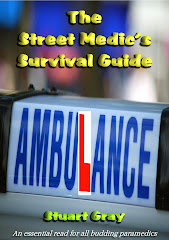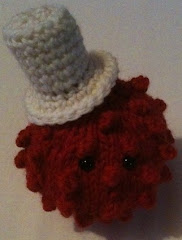Night shift: Six calls; one walked off; two (same call) assisted-only; two by ambulance; two by car.
Stats: 1 eTOH fit; 2 falls with minor cuts; 1 dislocated knee; 1 ?EP fit; 1 cold person; 1 fast heart beat.
A regular alcoholic with attitude had a fit in a small green where people lie out in the sun and after I’d treated him with sympathy and reassurance, he pushed me aside and walked off, telling me he needed a cigarette. It was too late to cancel the ambulance and I had to explain the wasted trip to the crew.
This was followed by a call to an underground station where two men had fallen over each other on the escalator. They had very minor cuts to their arms, legs and hands, so after cleaning the wounds up they continued their journey without further harassment from the NHS. Two voluntary services people were on scene when I arrived and they gave me a hand-over but it was as clear as day the injuries were so negligible you’d get worse in your own garden by falling onto a bramble bush – if you have such a thing in your garden.
A dislocated knee in the City next and I was meandering around corridors in a large office building towards the patient who’d swung on a table and lost the stability of his patella whilst working a night shift. He had a history of this and it took no more than ten seconds to reduce the knee (simply by straightening the leg), with the help of Entonox, so that I could take him by car to hospital to have it examined.
Reducing a Patellar dislocation is necessary for pain relief and to prevent further damage to the joint and if the patient is willing to have it done and the necessary skill is applied, it is a very straightforward manoeuvre. After the knee cap slipped back into place he was much more stable and his pain score dropped a few points - job done.
Getting him down to the car was the next problem – we were a few floors up and I had gone through a lot of corridors to get to this room. The solution came squeaking around the doorway – one of his colleagues wheeled in a post trolley and he stood on this as we carted him into the lift and out of the building. Even with a dodgy knee, he could see the funny side of that.
Later on I was sent to an underground station where a 25 year-old was fitting on the platform. The staff members on scene were taking good care of him when I arrived after a long, spiralling walk down the back steps with two police officers accompanying me.
The man had fitted three times for short periods I was told and he was epileptic and diabetic, so I checked his blood glucose and found it to be normal. He was lucid enough and that surprised me because, although his pulse was quite fast, he didn’t look as if he had exerted himself as epileptics tend to when they have fitted.
Then he told me he’d walked out of hospital because the nurses didn’t like him and that rang an alarm bell. He also told me he was on antidepressants, or had been. Then he had one of his ‘seizures’ and it wasn’t very convincing, so I think, as a professional person with the right to make a clinical decision, it was probably best that I decided not to administer anything for his ‘epilepsy’. He’d also been drinking alcohol and that negated drug therapy.
As soon as his ten second thrash on the floor finished he was perfectly lucid and able to answer questions again and regardless of my suspicions, I continued, as you do, to treat him as given, except for drugs of course.
In the early hours I was sent out to check on a 55 year-old man who’d called from a payphone to say he was cold. That’s it – just cold.
Normally this is a wasted journey because the caller usually walks off but after finding an empty phone box I spotted him wandering in my direction. He was shuffling and stooped.
I asked him why he needed an ambulance and he said ‘I just thought a few hours in the Emergency Department might heat me up’. At least he was honest about his reason for calling, so I did him the favour of driving him to A&E. He was cold but not so bad that it warranted emergency treatment. The nurse accepted him and I got a bit of a glance. What else could I do? The man was lost and couldn’t get home to the West Country where he lived in a hostel, so I did the human thing.
At a posh hotel a 68 year-old lady woke up with a fast heart beat; her husband was with her in the room when I arrived and he explained that she was normally fit and well but this had given her a fright. She had never experienced tachycardia before and the reasons for it range from the benign to serious, depending on many factors, including depletion of hormones necessary for the steady functioning of the cardiac electrical system. This is what I believe was happening to her; one of her glands was probably running out of juice, so to speak and, after a more thorough examination and a sound diagnosis by a doctor, she would more than likely be given a hormone to add to her diet for life. It’s common and nothing to worry about.
When the crew arrived to take her to hospital I got a handshake and a thank you from her husband. We don’t get much of that and it was nice to receive it.
Be safe.
Subscribe to:
Post Comments (Atom)















1 comment:
My previous and sadly now retired GP told my that reducing a joint and getting a split nail which is impacting into the nail bed are two of the easiest and yet most satisfying "tricks of the trade". He removed a broken nail on me which was impacted on to my thumb nail - the pain was extreme and suddenly it was gone! I felt like kissing his feet!
Post a Comment